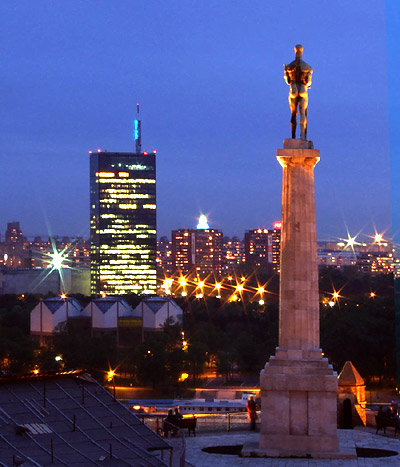
Although Serbia is rather a small country, it can proudly boast of its historical heritage, of a long and rich tradition , of its customs and beliefs.
Moreover, it can certainly be proud of the remnants of fortified towns and its fortifications, the most impressive and well-known of which is Belgrade Fortress – Kalemegdan.
Protected by the Republic of Serbia, this magnificent fortification was proclaimed the Monument of Culture of Exceptional Importance in 1979.
It comprises a park and a fortress located in the very city center.
Situated on a hilltop overlooking the confluence of two great rivers – the Sava and the Danube, the fortress represents one of the oldest populated town districts through history – it remembers the bygone age full of turmoil, tyranny and defense, as well as the days of liberation and freedom.
The history of Kalemegdan Fortress dates back to the 3rd century BC and corresponds to the history of the city itself.
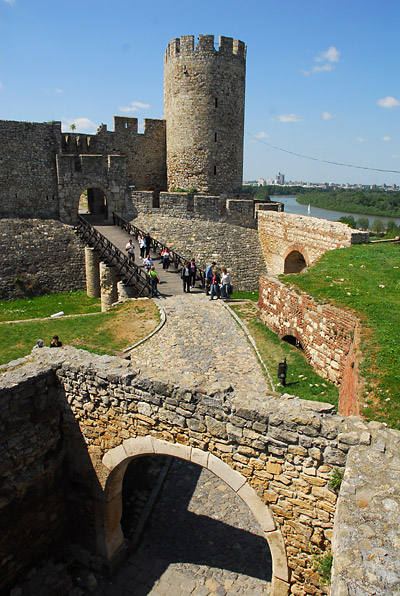
The productive soil at the confluence of the two rivers had been constantly settled even since the paleolithic period.
The fort was initially founded by a Thraco-Celtic Scordisci Tribe that assigned its name – Singidunum, meaning “Round Fort”.
Another interpretation of the name Singidunum is that it originated from a Thracian tribe’s name – the Sings and the noun dunum , meaning “enclosure, fortress, or town”.
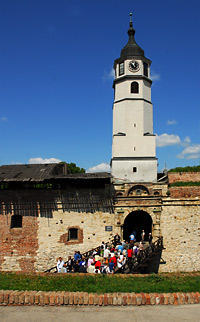 This rich farmland had been home to the Celtic tribe for almost 600 years until the Romans’ arrival around 40 BC, who constructed a large fortification to protect the fertile land.
This rich farmland had been home to the Celtic tribe for almost 600 years until the Romans’ arrival around 40 BC, who constructed a large fortification to protect the fertile land.
The division of the Roman Empire had brought new turbulent periods. Having become a border town of the Byzantine Empire and a spot of different cultural influences, the area was continually rulled by different groups of people, accumulating their impact into its rich history, or getting completely devastated, alternatively. The Fortress was reconstructed by the Byzantine Emperor Justinian I around 535 AD; however, in the centuries that followed it was repeatedly invaded by barbarian people, some of which being the Avars, Slavs, the Huns and many others.
The Fortress was conquered by the Turks in the 16th century and remained under the reign of the Ottoman Empire for the next three centuries (with brief periods of Austrian rule during which it was mainly rebuilt). The Turks left behind the name Kalemegdan – “kale” meaning “fortress” and “meydan” meaning “battlefield”.
Although perpetually exposed to devastation and unrest, the fortress continued to exist and remember many Serbian hardships – the Great Serbian Migration in the 17th century, the suffering during the Ottoman rule, the two uprisings against the Turks in the 19th century and many others. It was also severely damaged during the World War I and II; nevertheless, the monument “Victor” (Pobednik)proudly stands on the hilltop today, representing the protector of Belgrade and the peaceful symbol of the years to come.
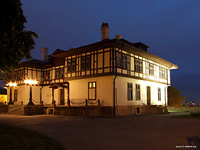 Being divided into four sections, Kalemegdan is certainly worth visiting . The lower town, the upper town, the Little Kalemegdan and the Great Kalemegdan offer visitors many sights, like Orthodox churches (Ružica and Sveta Petka), the attraction Roman’s Well (Rimski bunar), the Military Museum , Museum of forestry and hunting and many other places of interest. Also, what appeals to visitors most is the amusing Kalemegdan ‘s Zoo.
Being divided into four sections, Kalemegdan is certainly worth visiting . The lower town, the upper town, the Little Kalemegdan and the Great Kalemegdan offer visitors many sights, like Orthodox churches (Ružica and Sveta Petka), the attraction Roman’s Well (Rimski bunar), the Military Museum , Museum of forestry and hunting and many other places of interest. Also, what appeals to visitors most is the amusing Kalemegdan ‘s Zoo.
Museums in Belgrade Fortress
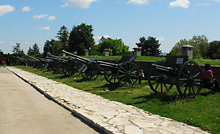 Going for a walk through the gorgeous park and nicely-arranged and colourful flowerbeds is undoubtedly a perfect way to spend your afternoon.
Going for a walk through the gorgeous park and nicely-arranged and colourful flowerbeds is undoubtedly a perfect way to spend your afternoon.
People who prefer sitting can relax on the many benches in the park, or in the narby cafés and restaurants. One of the most pleasant places is, surely, the sunlit Kalemegdan Terrace , a café with a garden ovrelooking the magnificient and breathtaking union of the two rivers.
Watching the sunset or just sipping famous Turkish coffee or a fruit juice is a tremendous experience on the Terrace. It is also a unique opportunity for photographers or nature lovers.
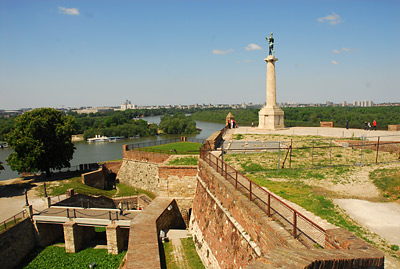
View from Kalemegdan Terrace
However, the walk through the fortress itself, through its old narrow passageways and many bridges can be an illuminating experience. Seeing Nebojsa Tower (Kula Nebojša) can be exhilarating and moving.
Initially serving for defence, it was later transformed into dungeon where many prominent Serbian patriots died. It is currently being reconstructed with the aim of creating a multifunctional hall for various cultural purposes and performances.
Tourists and visitors will soon have the opportunity to see a permanent exhibition relating to the history of the Tower, to watch theatre plays or take part in public speeches.
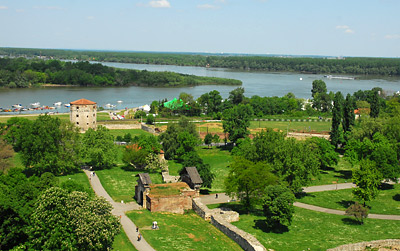
Nebojsa Tower (Kula Nebojša)
What is also interesting to mention about Kalemegdan is that its National Observatory , which is situated on Dizdareva Kula ‘s terrace, enables Belgraders and visitors to observe astronomical objects, using telescopes-refractors every Friday and Saturday throughout the year.
Many monuments and statues , as well as the Art Pavilion Cvijeta Zuzorić , the Music Pavilion , the Grand Staircase , sports and tennis playgrounds and restaurants can be found on Kalemegdan.
The Monument of Gratitude to France , a work of art by Ivan Meštrović , built in 1930, was created to express gratitude to the French who had helped the Serbian army in World War I. A bronze figure of a woman with a sword, at the top of the monument, symbolises France , and at the back of the pedestal is the inscription “We love France as she loved us, 1914-1918…” The green area around the monument was made resembling French parks.
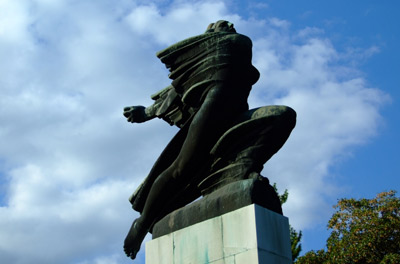
Monument of Gratitude to France
A memorial monument of handing over the keys of the Belgrade Fortressis located at the place where a Sultan’s declaration was read on 19th April 1867 , which stated that the fortress was submitted to the administration of Prince Mihailo Obrenovic and the Serbian army. It is a work of art by a sculptor Michael Paunović.
All in all, whether you want to take a stroll around the beautiful park, to survey the many museums in the vicinity, or just ramble around the mysterious paths of the fortification, you cannot fail but conclude that Kalemegdan is a never-ending story .
Dazzled by the overwhelming beauty of the surrounding nature, a visitor can never regret coming to this powerful place which tells the tale of former times, the tale of slavery and freedom.
Recommendation
-
Our recommendation

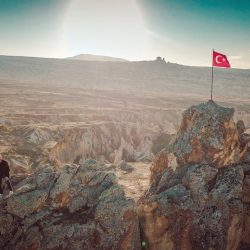
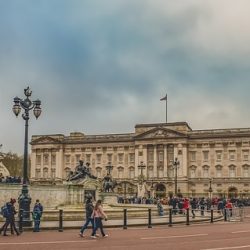

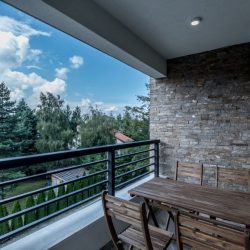

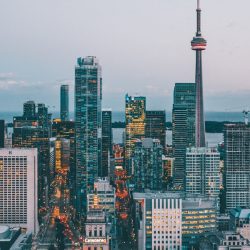

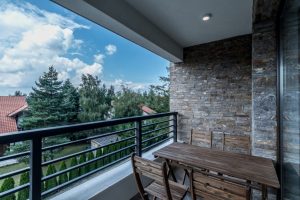
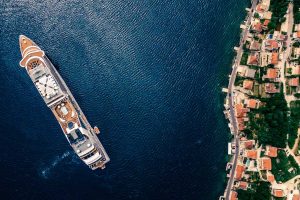





Add Comment